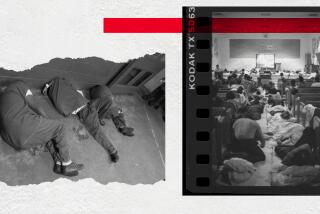Trial Over Jail’s Use of Isolation Cells Stirs War of Words
- Share via
The civil libertarians and jail inmates maligned them as “rubber rooms.”
Orange County officials preferred to call them “safety cells.”
A frustrated federal judge sought to quiet the linguistic debate in his courtroom, telling the sparring litigants that “we all know what we mean.”
But the issue cut deeper than mere words in U.S. District Court on Tuesday as attorneys debated the legal, ethical and medical problems posed by a block of small individual cells at the Orange County Jail that are designed to house inmates thought to be dangerously combative or self-destructive.
The controversial cells are the target of a civil suit brought by the American Civil Liberties Union, which charges that the so-called “rubber rooms”--barren save for a single hole in the floor for the inmate’s excrement--fail to meet even minimal standards of human decency.
Dr. Edward Kaufman, a UC Irvine psychiatrist who has studied jail conditions extensively, testified that the isolation cells, rather than calming potentially violent inmates, only create “a storehouse of anger that would intensify after they were out of the rubber room.”
Kaufman was one of a slew of medical experts that ACLU attorneys called on to testify Tuesday in hopes of convincing U.S. District Judge William P. Gray to order the Orange County Sheriff’s Department to halt the practice of keeping inmates in the detention cells.
Other counties also maintain such cells, and the ACLU charges that all are breaking the law.
The hearing was expected to continue today with further testimony from one inmate who has been held in the cells. The inmates said in their lawsuit that they were often made to sit naked in the empty cells for long periods of time. Without bedding, toilet paper or utensils, they contend, the conditions are vile and unsanitary.
Jack J. Donaldson, a former inmate who worked as a barber near the isolation cells, testified Tuesday that he saw an estimated 50 men hauled into the cells over an 8-month period. “It was kind of like a train station,” he said.
Donaldson charged that deputies often dragged inmates into the cells, punching them and kicking them to the floor. However, he could provide no dates or details.
But a state Board of Corrections spokesman said in an interview this week that state inspectors examined Orange County’s safety cells last year and found them to meet proper standards.
And Eugene R. Dorsey, psychiatric director at the jail, defended the use of the isolation cells in court Tuesday, saying that there have been no inmate deaths in them. “We think that that indicates they are safe and that they’ve earned their name” as safety cells.
Dorsey asserted that most of the several dozen inmates placed each year in the seven isolation cells eventually were returned in a more calmed state to normal detention housing, bearing out the effectiveness of the cells.
He explained that officials often deny inmates in the isolation cells such basic items as toilet paper, clothing and washing facilities in the belief that these inmates--who have shown violent or perhaps suicidal signs--may somehow use the items to hurt themselves.
But other experts in the psychiatric field disputed Dorsey’s view at the hearing.
Dr. Manuel Perez-Pabon, an internal medicine specialist in the Santa Ana area who worked at the jail until earlier this year, said the smell of urine in the cells was “very penetrating, very pungent, very repulsive.”
There was often dried vomit on the floor, he said, and “the appearance of the room was (like something) out of a detention camp movie.”
Times staff writer Dave Lesher contributed to this article.
More to Read
Sign up for Essential California
The most important California stories and recommendations in your inbox every morning.
You may occasionally receive promotional content from the Los Angeles Times.













